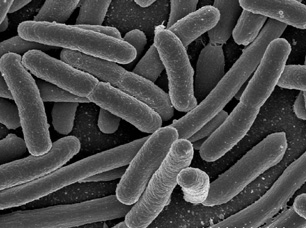Bacteria, E. coli and Total Coliform
| EPA Maximum Contaminant Level Goal (MCLG) |
Total Coliform | zero |

E. Coli
Bacteria are common. They occur naturally in water, and almost everywhere else.
Most bacteria are of no health concern because they do not cause disease in humans. These are called non-pathogenic bacteria. Pathogenic, or disease-causing bacteria, are responsible for such diseases as cholera, typhoid fever, infectious hepatitis, dysentery, and gastroenteritis.
The bacteria we hear most about is E. coli (which stands for Escherichia coli). It's a rod-shaped bacteria from the colifrom group—bacteria used as indicators of water sanitation. E. coli is found in the intestines and in the fecal matter of humans and animals, so when E. coli (usually accompanied by high chloride and nitrate levels) is found in water, it usually indicates that the water supply has been contaminated from sewage. It might get into the water supply, for example, through a broken well casing, a ruptured supply line, or runoff from a septic system or dumped sewage.
E. coli and other coliforms are of significance mainly as indicator bacteria. By itself, E. coli is most often non-pathogenic, but its presence indicates that more dangerous fecal bacteria are likely present. E. coli is always present in humans, and normally a newborn baby's intestines are inhabited by E. coli within the first 40 hours of life.
Water Treatment for Bacteria
Iron bacteria, a non-pathogen but a terrible nuisance, is treated mainly by chlorination. Often it is impossible to rid wells of the bacteria so perpetual treatment is required to control iron bacteria.
Pathogenic bacteria are treated in a variety of ways. Chemical oxidation is the most common. The most frequently used chemical is chlorine, but chloramine (a mixture of chlorine and ammonia) is gaining in popularity. Ozone is another powerful chemical oxidizer used to disinfect water.
Bacteria can also be removed by filtration. Submicron filters are excellent bacteria removers. In fact, ceramic filters, made by the world's oldest water filter company, were initially developed to remove bacteria from the polluted waters of the Thames. Filters that are classed as microfilters and ultrafilters are effective against bacteria, as is reverse osmosis, though manufacturers of reverse osmosis do not normally claim bacteria removal as a function of their products.
Ultraviolet light is another standard defense against pathogenic bacteria. UV is actually classified as a sterilizer because it works by disabling the microbes' ability to reproduce.
U.S. water supplies were first chlorinated in the early part of the 20th century. Control of bacteria in drinking water, combined with great improvements in sanitation, represent the most significant single cause of increased human longevity.
Source: Enting Engineering Handbook and Wikipedia, Photo: WikiMedia, author: Rocky Mountain Laboratories, NIAID, NIH
Site Index
Filtration Systems
- Aeration for Iron & Sulfide
- Backwashing Filters
(whole house & well units)
- Chlorine & Chemical Injectors
- Countertop Water Filters
- Emergency Filters
- Garden Hose Filters
- Reverse Osmosis, Residential
- Reverse Osmosis, Commercial
- Shower Filters
- Specialty Filters
- Ultraviolet Systems
- Undersink Filters
- Water Softeners
- Whole House Filters
Cartridges
Parts
- Replacement Parts
- Faucets
- Filter Media
- Fittings
- Housings
- O-rings
- Pumps
- Pura UV
- R.O. Parts
- R.O. Tanks
- R.O. Booster Pump
- VIQUA UV